How To Bake Simple Sourdough Bread: A Beginner's Guide
This post may contain affiliate links.
This beginner's sourdough bread recipe is really easy to follow. I'm going to show you, step by step, how to use your sourdough starter to make a crusty loaf of sourdough bread with a beautiful open crumb. And the best thing is that this sourdough bread recipe is very hands-off! Perfect for making sourdough on a busy schedule.
The full, printable recipe is at the end of this guide, complete with videos and photos to help you along the way. You can also use this table of contents to jump to any point in the post you would like.
What is Sourdough Bread?
Sourdough bread is made with a wild yeast starter, giving it that signature tangy flavor and long, slow fermentation. The result is a loaf with a soft, airy crumb and a crispy, deep golden brown crust that’s hard to resist. Take a peek at what a true sourdough loaf should look like.
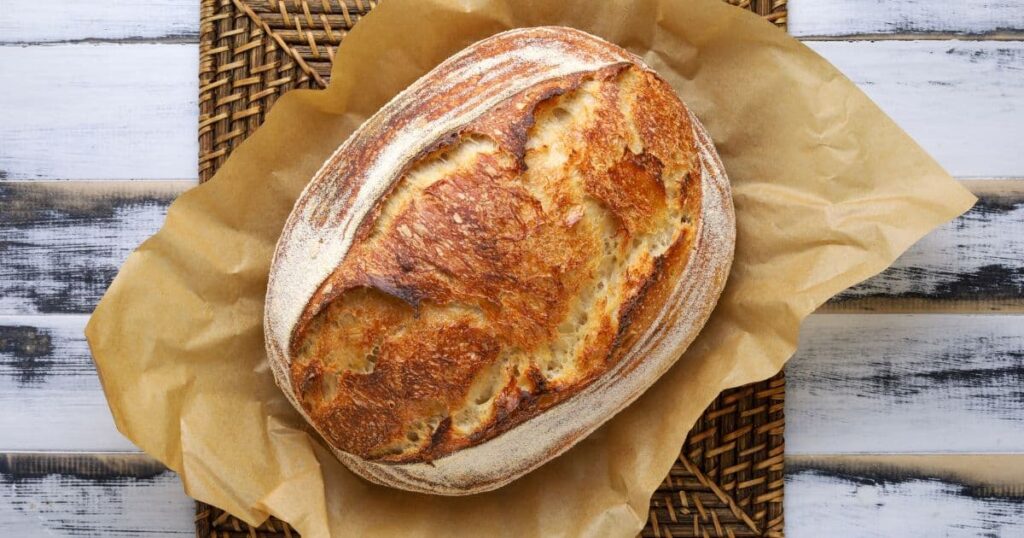
Why You'll Love This Recipe?
Forgiving for beginners – even if you’re new to sourdough, this recipe is approachable and easy to follow, with plenty of instructional photos and videos.
Perfect for Busy Schedules – With three kids and a hectic life, I bake sourdough in the middle of chaos. This recipe is my go-to for creating delicious bread with plenty of hands-off time, making it easy to fit into any schedule.
Consistently delicious results – soft, chewy crumb with that perfect golden crust every time. This recipe has been used by thousands of home bakers in my sourdough community to create consistently great sourdough bread.
⭐️⭐️⭐️⭐️⭐️ "better than the Sourdough bread in San Francisco"
“I made my first loaf of bread using your recipe and it was amazing! My family thought it was better than the Sourdough bread in San Francisco! Thank you for a wonderful recipe!”
- Rose Prince
⭐️⭐️⭐️⭐️⭐️ "One of the prettiest loaves I have made this year"
I am a self-taught sourdough baker and have been enjoying a modicum amount of success with my bakes for the past ten years. One thing I have always struggled with however, is the bulk ferment. I stumbled across this blog when troubleshooting, and proceeded to click just about every link off this page. I have learned SO much, and am very grateful for people like this generous woman who so thoroughly shares their hard won knowledge. So thank you very much for that, and if you’ve made it this far- try this recipe! One of the prettiest loaves I have made this year, and I’m excited to try the longer cold ferment recipe as well. Cheers from Alaska!!
- Mimi from Alaska
What Do You Need?
These are the basics that you'll need on hand to have success with this recipe.

Ingredients
Sourdough Starter - The absolute most important thing when making this sourdough bread recipe is to have a super bubbly, active sourdough starter. New to sourdough? You can follow my step-by-step guide on how to make a sourdough starter. You can check if your sourdough starter is ready to bake with. If your sourdough starter isn't ready to bake this sourdough bread just yet, why not try this crusty sourdough discard loaf or this easy sourdough discard sandwich bread.
Bread Flour - High protein bread flour is essential for making sourdough bread. If you want to use whole wheat flour, I recommend this whole wheat sourdough bread recipe.
Salt - use a good quality, non iodised salt to add flavor to your dough and help to strengthen the gluten of the dough. You might like this post on the role of salt in sourdough bread.
Water - just like when you make sourdough starter, good quality, filtered water is best.
Rice Flour or Semolina Flour - You'll need rice flour or semolina flour to prevent your sourdough from sticking to the banneton.
Digital Scale - This is so important! Weighing your sourdough ingredients will ensure you're measuring accurately and give you a much better chance at sourdough success.

Equipment
Spatulas & Dough Scrapers - A long spatula or jar spatula is handy, not just for your sourdough starter, but also for mixing sourdough bread in the initial pre mix and autolyse stages. A dough scraper is handy to flip your dough out of the mixing bowl.
Banneton - I highly recommend using a banneton (proofing basket) to place your shaped dough into. If you don't have a banneton, a bowl or other banneton alternative is fine. I generally use a 9" or 10" banneton, but you can find the right one for you in this banneton sizing guide.
Parchment Paper - A piece of parchment paper is essential for lifting the shaped dough into your Dutch Oven.
Dutch Oven - A Dutch Oven or Cast Iron Baking Pan will give you the best results when you bake your sourdough loaf. If you don't have a Dutch Oven, you can check out these ideas for baking sourdough without a Dutch Oven.
If you want a more in depth look at the equipment I use in The Pantry Mama kitchen, check out this guide to sourdough baking equipment. You might also like this guide to the best Dutch Oven for sourdough bread.

What I do differently ... and why you should too
There are literally thousands of sourdough recipes out there. Why should you use this one? What do I differently that will make this recipe work for you in your kitchen?
- Amount of sourdough starter - I recommend 50g of sourdough starter when you first start out, but you can easily increase this to 100g if it's cooler. I've written a guide to changing the amount of sourdough starter in a recipe to help you do this when you need to.
- Overnight Bulk Ferment - I love using an overnight ferment, which many people try to avoid, particularly with a beginner's sourdough bread recipe. You can do the bulk ferment during the day, but once you're confident in how your dough looks when it's ready to shape, an overnight bulk ferment is a game changer in helping you fit sourdough into your busy schedule.
- Let the dough double - If you don't allow your dough to fully bulk ferment, you'll be short changing your yourself (and your bread). The dough needs to be puffy, like a giant marshmallow, while still maintaining some of it's energy so that it gives you the best oven spring when it hits the oven. Trust me on this, give your dough time to develop and bloom.
- Semolina Flour - I recommend using semolina flour to flour your banneton or proofing basket rather than rice flour. This is just personal preference, but if you haven't tried semolina, I urge you to give it a go. You might just love it as much as me. Plus, it's the best for stopping your sourdough discard pizza dough from sticking to pizza peels, so it's super handy to have around.
Kate's Recipe Tip
- When you're beginning to bake sourdough, the best way to learn is to watch your dough. There's nothing worse than over proofed dough that fails to provide good oven spring.
How to Make Simple Sourdough Bread
Making this easy sourdough bread recipe is really easy! There's no kneading and a lot of the time will actually be hands off. You're going to read a lot of terminology in this sourdough bread recipe. If you aren't sure of some of the words, you can use this sourdough glossary.
Here's an overview of what you need to do to make delicious sourdough bread in your own kitchen (you can find step-by-step instructions in the recipe card).
1. Mix the ingredients - this is where you'll do a quick autolyse or fermentolyse in this case).

2. Form Up the Dough - turn the clumpy dough with dry bits in it into a more cohesive dough ball by moving the dough around the bowl to start the gluten development.
3. Stretch & Fold - this is a technique used to move the dough around the bowl and develop the gluten network in your dough. It basically means to stretch the dough up and then fold it over itself. You move clockwise around the dough and perform a stretch and fold at 12, 3, 6 and 9 o'clock. You can see me doing this in the video inside the recipe card at the end of this post.
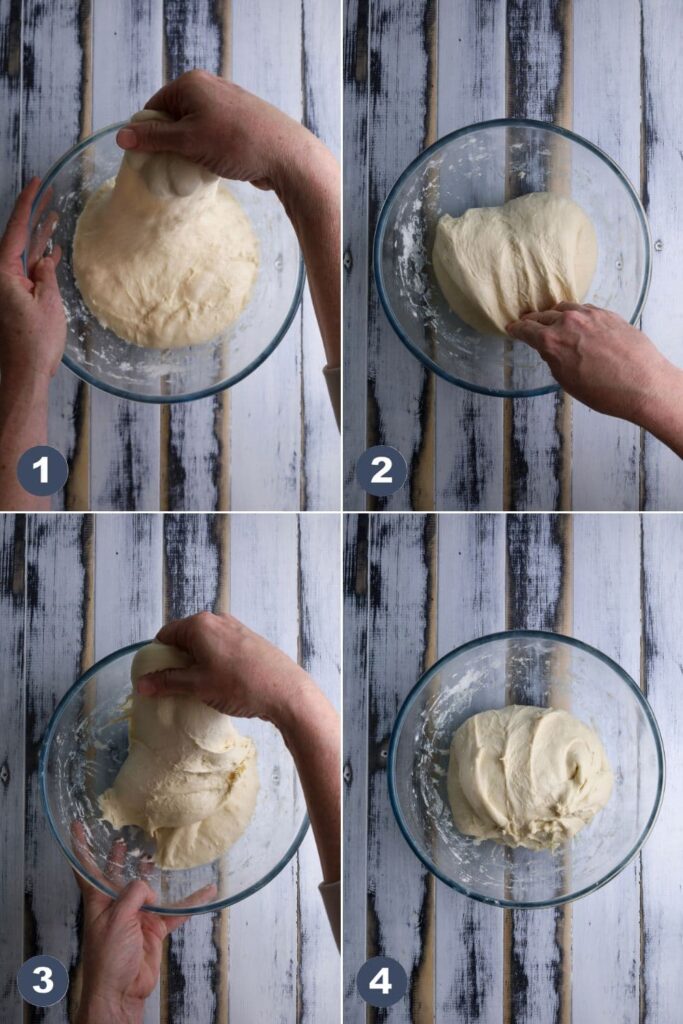
4. Bulk Fermentation - The bulk fermentation in any sourdough recipe refers to the "first rise" or the longest fermentation period. It's always done at room temperature. It's when the magic happens. You're looking for your dough to double. You'll know your dough is perfectly fermented and ready to shape when it has a smooth, domed top. It will be soft and pillowy - but not sticky (just slightly tacky). Use this guide to check whether bulk fermentation has finished.
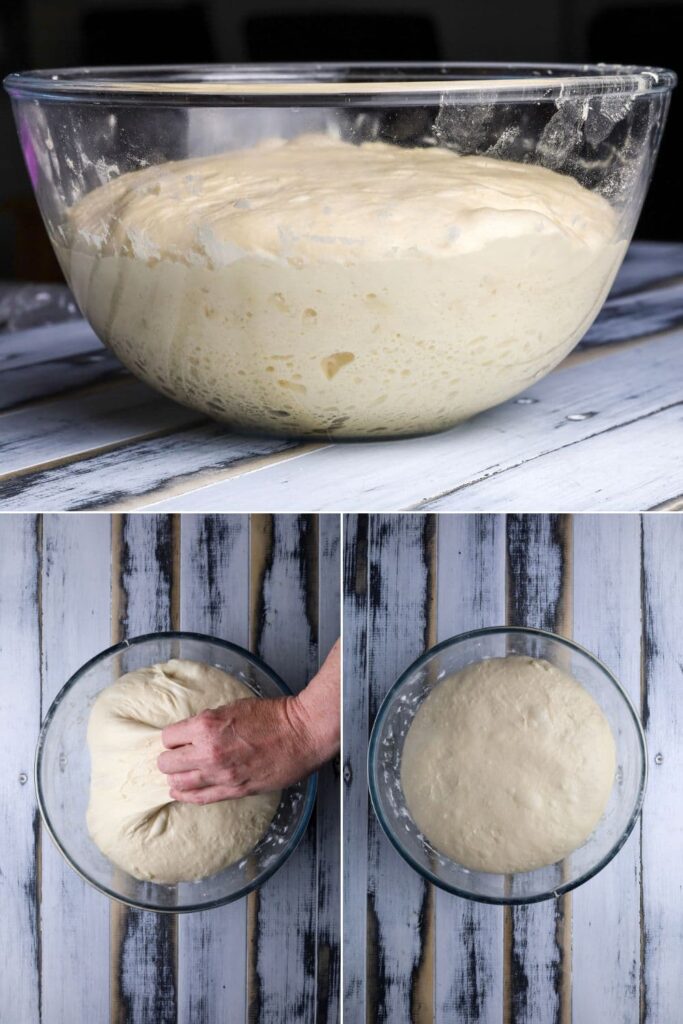
5. Shaping - shape your dough into either a batard or a boule and place it seam-side up into your banneton basket Surface tension is really important here!
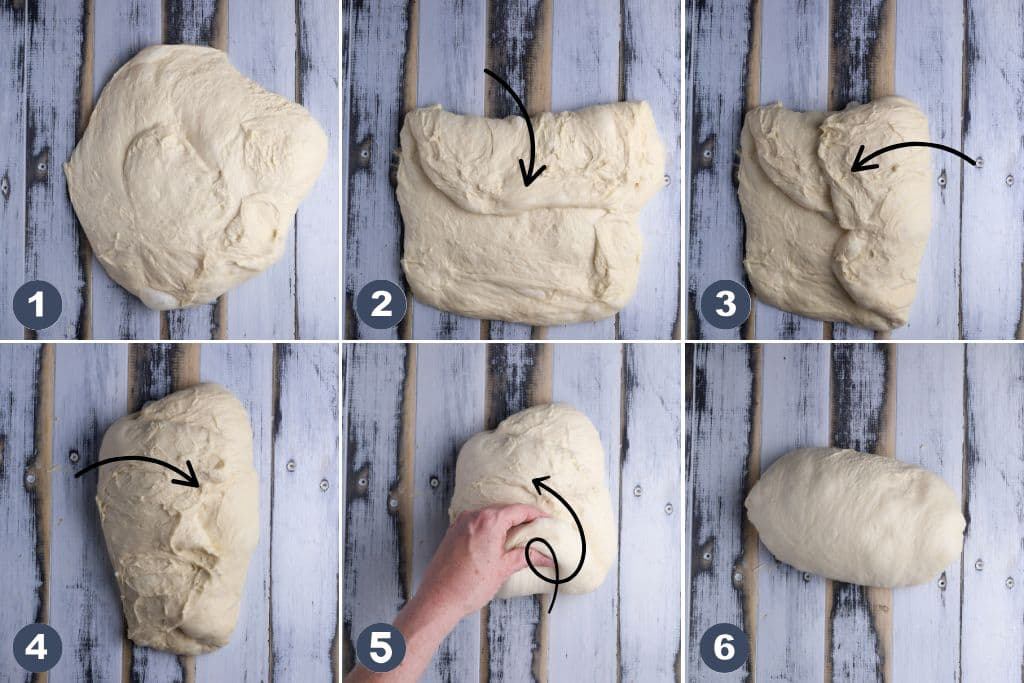
6. Cold Fermentation - Often referred to as the cold proof, this is the time when your dough will develop it's signature flavor. You can leave your dough in the refrigerator for up to 36 hours. You might like to read this information on proofing sourdough in the refrigerator.
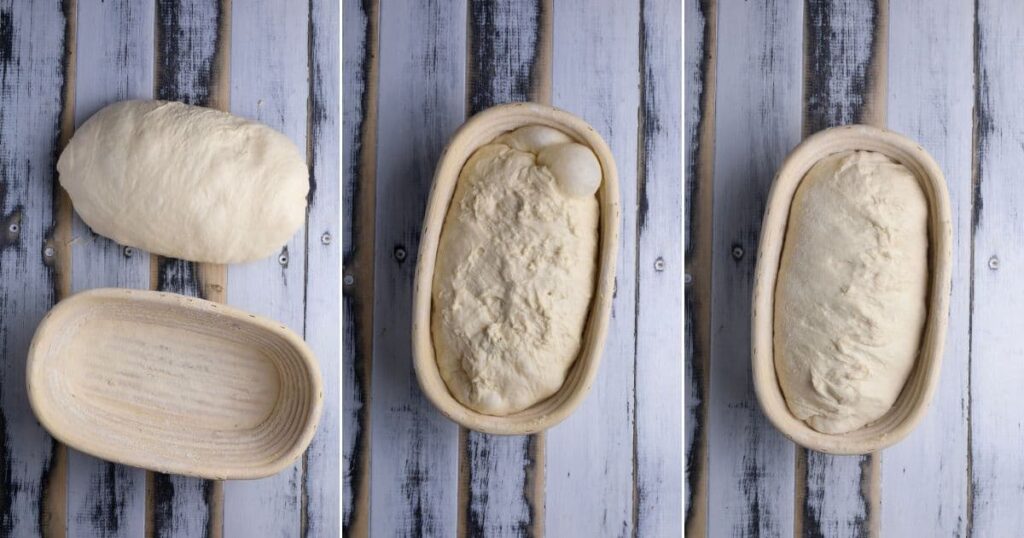
7. Let's Bake - You'll need to preheat your oven, with your Dutch Oven inside. You need to place your cold fermented dough into the hot Dutch Oven using parchment paper.
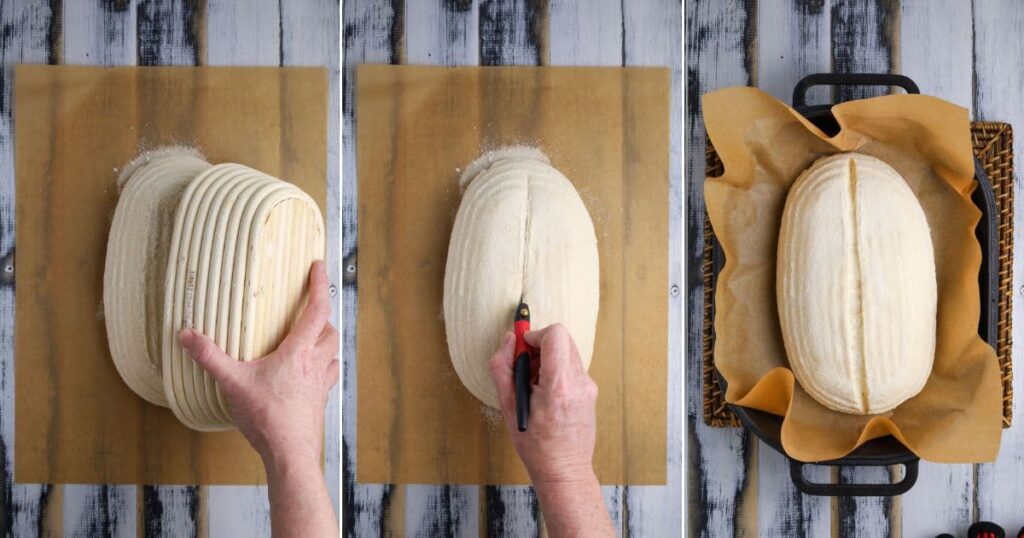
Don't cut your sourdough loaf right out of the oven. Allow it to cool completely before slicing (usually around 4 - 6 hours). Of course you can cut into your loaf sooner, but there are so many benefits to waiting until the loaf has fully cooled. Check out the best bread knife for sourdough bread and my best tips for slicing sourdough bread.
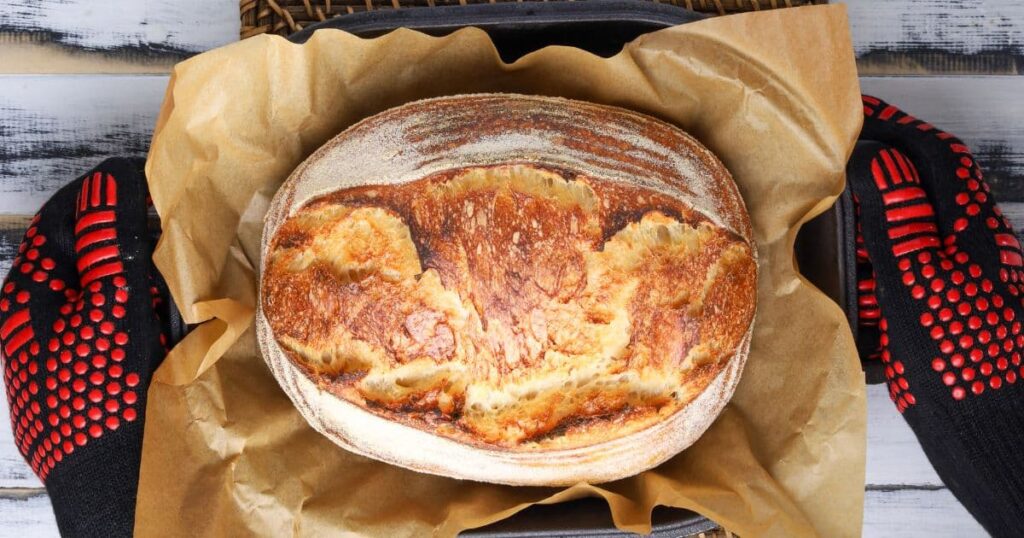
Baking Timeline
One of the other keys to successful sourdough is create a sourdough baking timeline that works for you. Many of my sourdough failures (and indeed any cooking failure) occur because I start and then I get distracted by kids and I'm not able to come back and finish.
Or you have to go out right when you are supposed to be doing stretch and folds (you can see how I deal with this in my Sunday Sourdough baking timeline).
So while my sourdough baking process has a few different stages and some suggested timings, it's not absolutely critical that you follow them to the letter. If your starter is super active and you weigh your ingredients correctly then you will be off to a fantastic start.
Let the rest unfold. Listen to your instincts. Watch the dough, not the clock.
My timeline for this baking simple sourdough bread looks something like this - but it's all negotiable.
| TIME | PROCESS |
|---|---|
| 1pm | Day 1 - Feed my sourdough starter so it's ready to mix the dough later on in the day. |
| 5pm | Premix and Autolyse (while I cook dinner) |
| 6:30pm | Form into a smooth ball, allow the dough to rest for 30 minutes while I clean up dinner and do the dishes. |
| 7pm | Perform 4-6 sets of stretch and folds over the next 2 hours while the kids do their homework and chill out before bedtime. |
| 9pm | Cover the dough and leave on the counter overnight for bulk fermentation (ensuring it's not too warm in the kitchen). |
| 6am | Day 2 - Shape and lift the dough into a banneton. Pop it in the fridge for cold fermentation. (I could bake my sourdough bread from around 2pm today if I wanted to, I just prefer a longer cold ferment). |
| 2pm | Day 3 - Bake my sourdough loaf in a hot oven after a 32 hour cold ferment. |
| 7pm | Finally cut into m delicious loaf of sourdough bread, slathered with cultured butter! |
Troubleshooting Tips
I've baked thousands of loaves of sourdough bread using this very recipe. Everyday, I get asked for advice on what went wrong in other people's bakes. There are generally 5 areas that go wrong when baking sourdough bread:
- A weak starter - this is generally the root cause of "failed" sourdough. Remember, a young starter can still quite weak. If you're not sure whether your starter is mature, read about when sourdough starter is ready to bake with. You can also read my post on how to strengthen a sourdough starter.
- Under Fermentation - under fermentation will give you gummy bread that doesn't seem to bake through. Not sure how to fix under fermented sourdough? My guide to under fermented sourdough will walk you through the process.
- Using too much water - all flour absorbs water differently, but higher protein bread flour is always best. Too much water will cause sticky, unmanageable dough. Read more about how to fix sticky sourdough.
- Over Fermentation - while less common than under fermentation, over fermentation can occur during bulk fermentation, but also during cold fermentation. Read more about bulk fermentation vs cold fermentation.
For even more troubleshooting solutions, you can read these common sourdough bread troubleshooting tips.
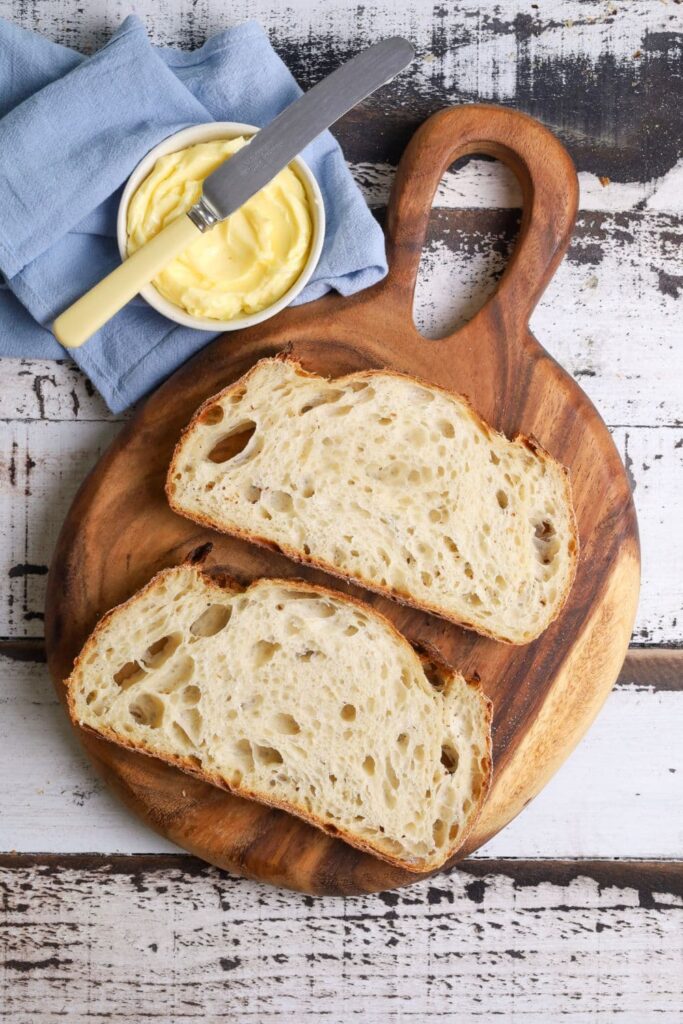
One Last Thing ...
We all see photos of the lacy, holey sourdough bread - they really do look amazing and it is certainly an achievement. But don’t let these photos make you feel unhappy about your loaves. Some questions to ask yourself - is my bread edible? Does it have good flavour?
While there is always room for improvement, the perfect bread is bread you enjoy baking and eating. I don’t like my sourdough with too many holes - I can’t slather butter on it when there’s too many holes 😉
Embrace the imperfection and know that your sourdough is a completely unique result of the different flours, water, wild yeasts and bacteria in your town, home & country.
That's pretty special if you ask me!
What's Next On Your Sourdough Journey?
- Learn how to add inclusions into sourdough bread.
- Try a higher hydration sourdough bread recipe.
- Learn how to bake sourdough in a loaf pan.
- Want a smaller sourdough loaf? Try this small batch sourdough bread recipe.
- Make these sourdough baguettes.
- Learn how to make sourdough at higher altitude.

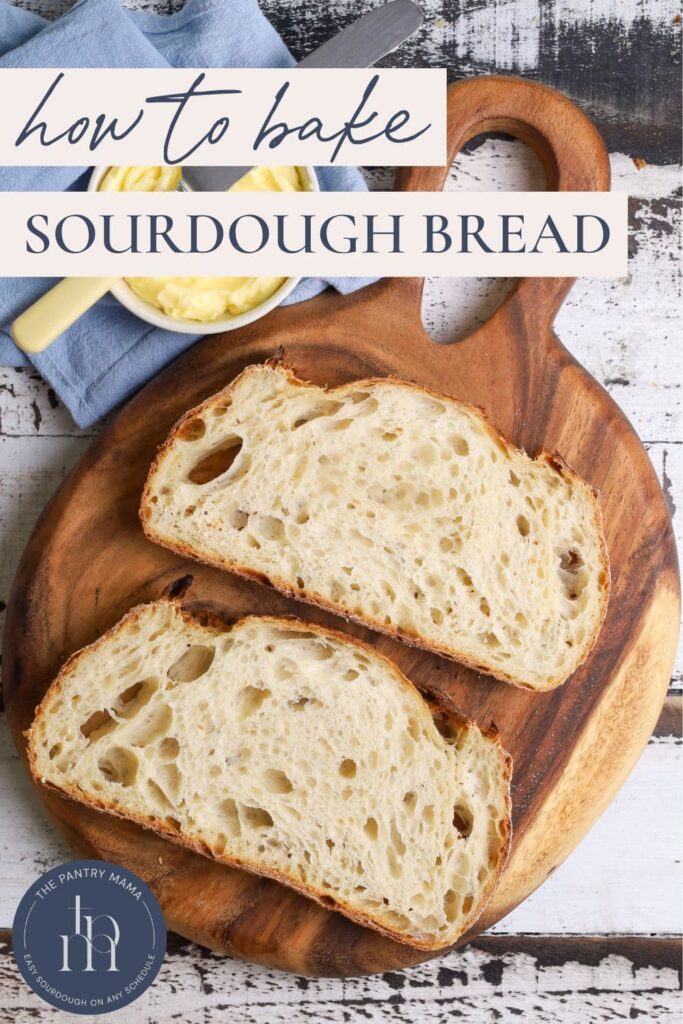
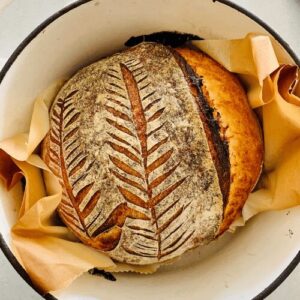
Simple Sourdough Bread Recipe
Video
Equipment
- Mixing Bowl (use a 3L glass Pyrex bowl)
- Digital Scales (this is essential)
- Banneton (proofing basket)
- Dutch Oven (you can see the Dutch Ovens I use here)
Ingredients
- 500 g Bread Flour
- 350 g Water
- 50 g Sourdough Starter
- 10 g Salt
Instructions
- Autolyse - Premixing The DoughWeigh out your sourdough starter and water into a large ceramic or glass bowl. Mix the water and starter together briefly. Then add your flour and salt and mix whole lot together to form a shaggy dough. You can use a dough scraper or long jar spatula to do this. I don't like using hands at this stage as it's way too messy!The dough will be fairly shaggy and only just brought together. You might wonder how this will turn into bread, but just wait, time is your friend and the dough will change in around an hour.
- Cover your bowl with a plastic bowl cover or damp dish towel and let it sit for around 1 hour. This process is called the "autolyse" and allows your flour to soak in all the water and become hydrated. You can see how the dough has changed in this photo.
- Forming Up The DoughAfter the dough has been through autolyse you need to bring it together into a ball. Work your way around the bowl, grabbing the dough from the outside, stretching it up and over itself, into the centre, until a smooth ball is formed. You shouldn't need more than about 20-30 stretches to form the ball. You'll notice that the dough is fully hydrated after soaking all the water up. It will be fairly sticky but as you bring it into a ball, it will become smoother and shinier.
- Once the dough has formed into a smoothish ball, pop the plastic bowl cover back on and allow it to rest for around 30 minutes.
- Stretch & Fold - Creating StructureOver the next few hours you need to create some structure for your dough by "stretching and folding". Aim to do around 4-6 sets of stretches and folds. For each set, stretch the dough up and over itself 4 times. Leave around 15 minutes in between each set. Again you do not have to be exact with time, but you need to do at least 4 sets over 2 hours.
- Bulk FermentOnce you've finished your stretch and folds, place the plastic bowl cover or damp tea towel back over your dough and let it rest and ferment (a plastic cover is a better option for this stage).See notes below for more info on this step.
- Shaping The DoughOnce your dough has finished it's first ferment, it's time to shape it into either a boule or a batard. I don't like using flour for shaping, however if you feel you need it, give your counter a really light dusting of rice flour or semolina flour.Use a silicone dough scraper to gently ease the dough out of the bowl. You want it to land upside down on your counter so that the smooth top of the dough is on the countertop and the sticky underside is facing up. This will make it easier to shape and allow you to use the dough to create it's own surface tension.I like to make batards, but you can also create a boule. You can see a video of me shaping the dough at the top of this recipe card.
- Placing Into A BannetonOnce the dough is shaped into a boule or batard with plenty of surface tension, place it into your banneton smooth side down, so your seam is on the top. Stitch the top of the dough together if you need to.Lift your dough around the edges to pop a little more flour if you feel it needs it. Just try to handle the dough as little as possible and be really gentle as you really want to preserve all the gases and air bubbles that have formed during your bulk ferment.
- Cold FermentNow the dough is in its proofing basket, cover it loosely with a plastic bowl cover or damp dish towel and place into the refrigerator.Try to leave it in the fridge for a minimum 5 hours up to a maximum of around 36 hours. The longer you leave it the better your bread will be! A longer cold ferment creates beautiful blisters on your crust and a deeper sourdough flavour.
- Preparing To BakeOnce you're ready to bake your sourdough, you'll need to preheat your oven to 230C/450F. Place your Dutch Oven into the oven when you turn it on so it gets HOT. Try to preheat for around 1 hour to ensure your oven is super hot - but you know your oven so just adjust this time if you need to.Leave your dough in the fridge until the very last minute - placing a cold dough into a hot oven will give you a great oven spring.
- Let's Bake Your Sourdough BreadWhen your oven is at temperature, take your sourdough out of the fridge. Gently place it onto a piece of parchment paper.Make sure that you make the baking paper big enough to use the edges as a handle to lower to dough into your Dutch Oven.Gently score your bread with a bread lame or clean razor blade. At minimum a large cross is sufficient, but you can get as artistic as you like. Check out this guide to scoring sourdough bread.Carefully take your Dutch oven out of the oven. Place the sourdough into the pot using the parchment paper as a handle. Put the lid on and place into the hot oven. BAKE TIME:30 Minutes with the lid on at 230C/450F plus10-15 Minutes with the lid off at 210C/410F
- Finishing The BakeWhen you remove your dough from the oven, carefully remove it from the dutch oven as soon as possible and place on a wire rack to cool.
Notes
- Notes on Flour: This recipe is written using strong Bread Flour. Bread flour has a higher protein content than All Purpose flour. If you choose to use All Purpose flour you may have a different result because of this. You might choose to use this sourdough bread recipe with all purpose flour. You can read more about the differences between All Purpose Flour and Bread Flour.
- Notes on Sourdough Starter: This recipe is based on you having an active starter that you have fed a few hours before starting your bake (check out the best time to use sourdough starter). You might also find these instructions for how to make a sourdough starter helpful.
- Notes on Stretch & Folds: If you are going to do the stretch & folds on your bench top, spray your surface with water mist rather than using flour. You can leave the dough in the bowl if you want to. Wet your hands to stop the dough sticking - although it shouldn't be too sticky. It will get less sticky as you do your stretches and folds. For more information on how to do stretch and folds, go here.
- Notes on Bulk Fermentation: If your home is warm then your dough will ferment a lot faster and could be done in as little as a few hours. If it's colder, it will take longer, possibly overnight.
I would recommend that you try to do your first few bulk ferments during daylight hours so that you can watch your dough closely.
Once you're more familiar with the process - and the temperature of your home - you will be able to do overnight ferments. You will know your dough is ready to move to the next stage when it has *just* doubled in size. It will be fairly wobbly and full of bubbles. You should be able to see large air bubbles under the surface of the dough.
You don't want to let it go any further than doubled as it will be over fermented.
If you want to do an overnight ferment, but your home is warm, consider using a little less starter (ie 25g).
Less starter means your dough will take longer to ferment and you will reduce the risk of over fermenting your dough. You'll find more information on these topics here:
When is my bulk ferment finished? What is the difference between cold ferment and bulk ferment? Why does the amount of starter matter?
- Notes on Baking: If you're worried about the base of your bread burning, place a baking sheet on shelf underneath your Dutch Oven - it works! If you're worried about your bread not being cooked all the way through, turn the oven off and place your dough straight onto the oven rack. Leave the door ajar and let your bread rest there for a few hours. Make sure you don't close the door or your sourdough will sweat and you'll get a wrinkly, soggy crust. Remember not to cut into your loaf too soon - you'll need to let it cool for at least a few hours (4-6 is best).
Nutrition

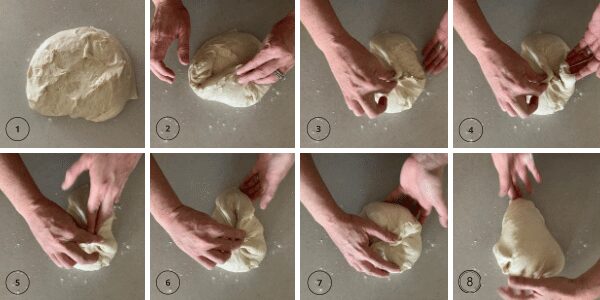
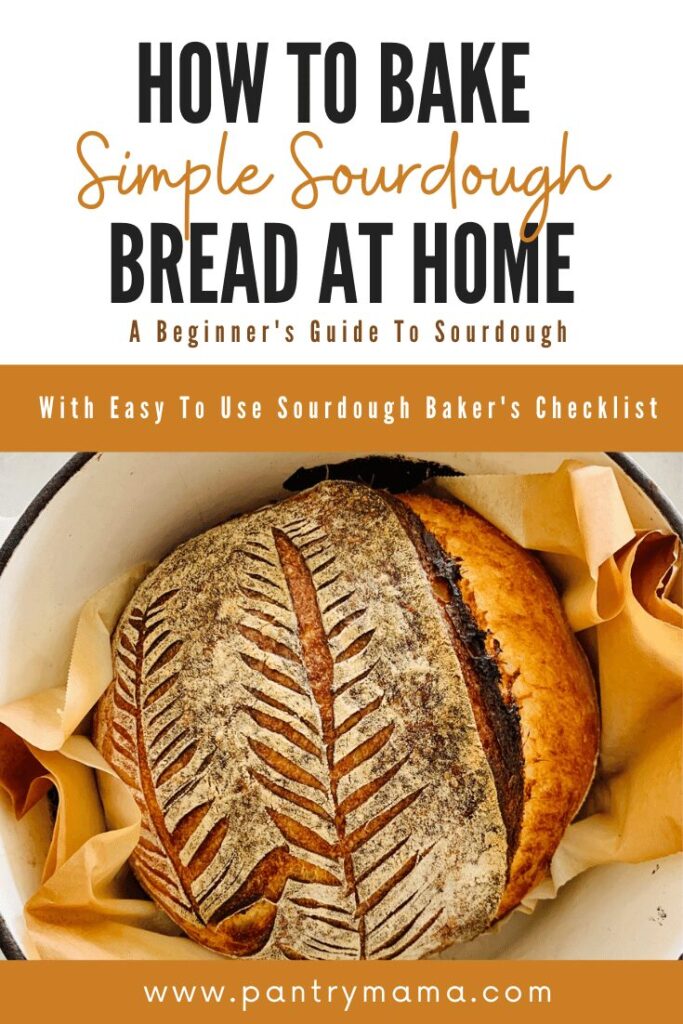


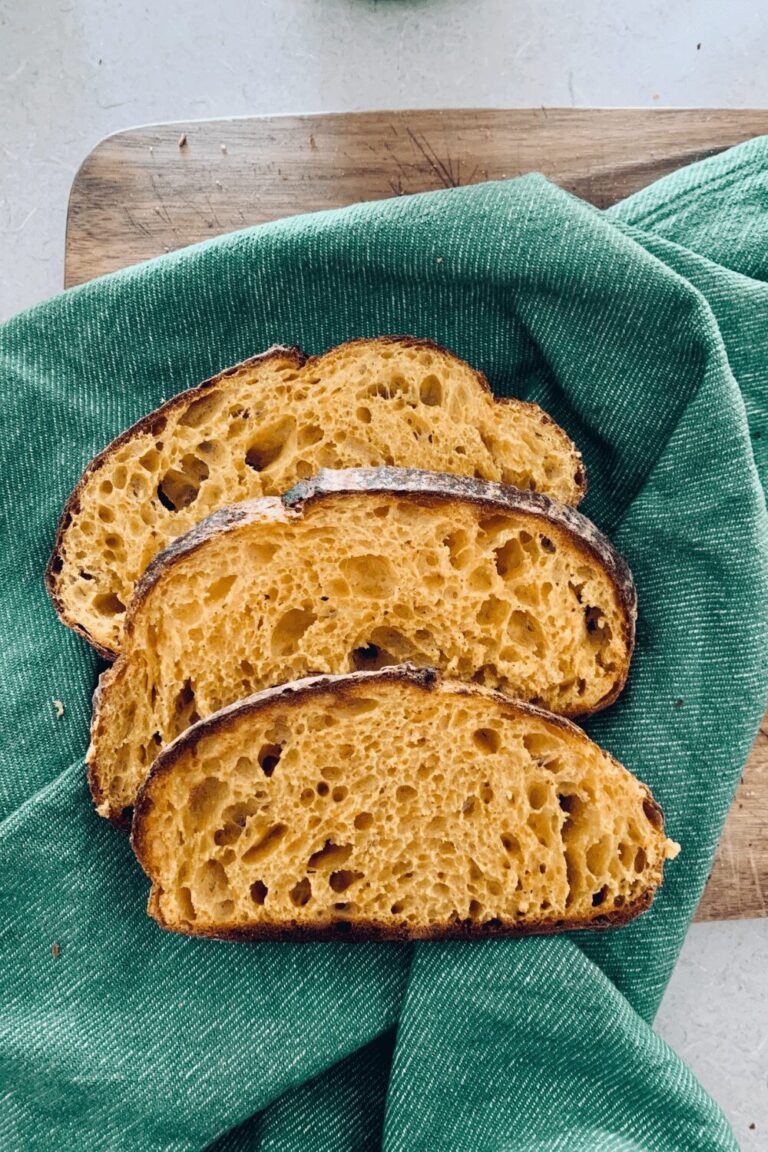

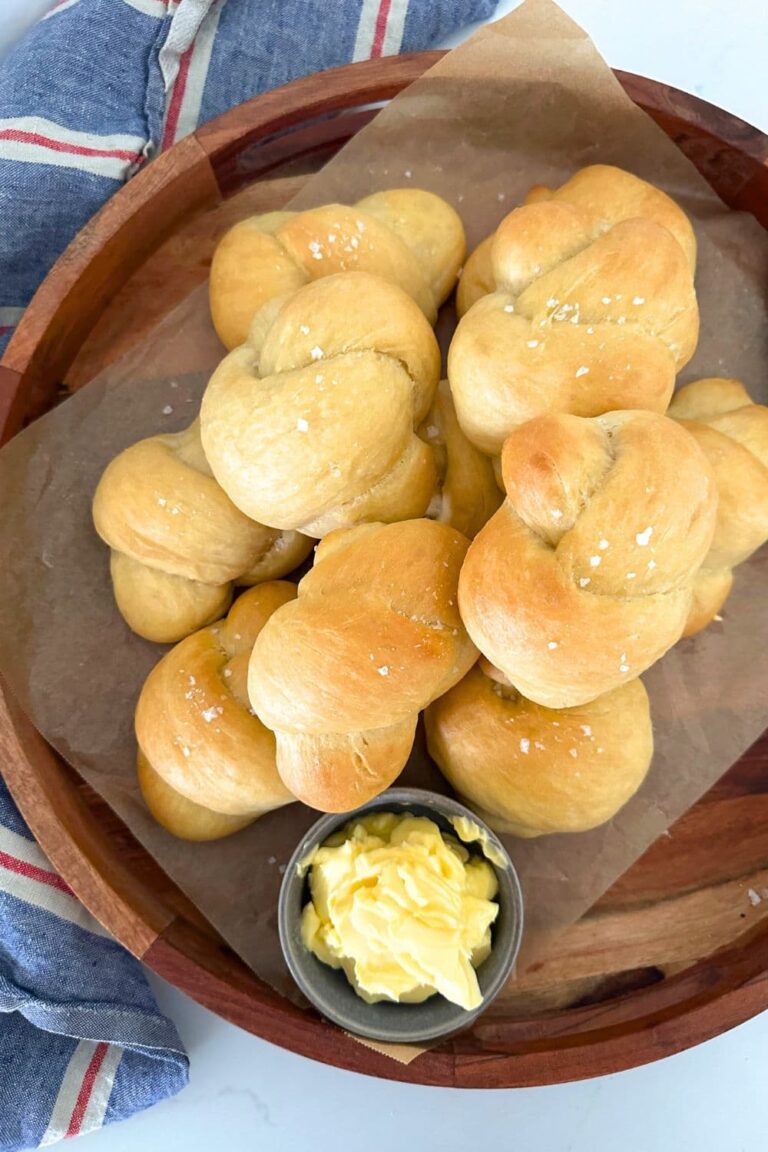

Is it possible to do the bulk ferment in the fridge also? Will that enhance the sourness of the final product?
Bulk fermentation should really be done at room temp to get a good ferment and bubble going. You can do your second ferment in the fridge as you want this to be much slower.
Can you do the bulk ferment in a proofing box at 85 degrees? I'm trying to find a way that fits my schedule. I love the idea of second ferment in the fridge which allows flexibility on when to bake.
Hi Kate. I'm new to your blog and have already made some sourdough bread looking at others' recipes. How does humidity afects the process, since my dough surely doesn't follow timings even though I live in a hot country, and how do I get a less sour flavour, since I'm doing this for the nutrition part, but don't really like sour or tangy flavours, more of a mild flavour lover?
Love this Recipe! I increased the hydration to 85%and typically use 60g of starter. My starter is very active! My question is is it best to use convection if its available, and if so does that change the baking time?
When doing a double batch for 2 loaves, when is it safe to cut it in half? After the bulk ferment? And then separate jnto banatons?
I want to thank you for your site and all the wisdom you've shared! I'm just taking my 5th loaf out of the oven and earlier made English muffins. These will be hostess gifts to some friends today. Everyone loves getting a beautiful yummy loaf of bread!!!
I have been dabbing in sourdough since the beginning of the pandemic -- following other "gurus" with mixed results. I came upon your recipe while searching for how to get the little blisters on my crust although my real problem has been too flat loaves. Following your simple and clear instructions, it was immediately obvious that I was quickly building more dough strength with less work and confusion. Same starter, same proportions, much taller loaf. My problem now is that the top of the loaf is so high that the top is close to burning before the sides have browned. Haha. First world problems. I don't expect perfection and will continue refining my techniques. Oh, and I got the tasty blisters, too. Thanks for setting me on a better path. Greetings from Medellín, Colombia.
Well, I followed your recipe and directions. This is my second attempt at baking a loaf. My starter is active and about 3 weeks old. I started with: 50G starter, 350g water, 500g flour, and 10g salt. Stretch and folds looked good, except the dough was a little wet. Did 4 stretch and folds. Bulk fermented 23c room for 6 hours. Did not rise. Some bubbles. Too sticky to handle even with rice flour. Could not go into a tight ball..just a sticky, flat mess. Floured and put in a banaton in the fridge. That's the point I'm at right now. I'll leave it in the fridge to cold ferment and see what happens. Not sure where I've gone wrong.
When you do the stretch and fold on the bench, do you transfer it to the bowl each time or leave it on the bench?
Always back in the bowl and covered.
What temperature should your baked bread reach when it's done? In ⁰F?
Just wondering, if you use the long banneton, how do you bake it ? As most Dutch oven would not fit the long bread loaf. Sorry if thats a silly question
I do my stretch and folds right in the bowl, it works great for me.
After 50 stretches to form the ball and before the 4 to 6 sets of stretch and fold, the dough is still very sticky and not smooth. What can I do?
I stretch and fold right in the bowl.
Please csn you tell me what you consider a cold home and what you consider a warm home? What temperatures differentiate them?
Can I use AP or bread flour instead of rice flour to dust the tea towel/banneton with??
How does any body have enough time in a day for al these hours long steps? Do you bake at midnight then slice it at 4:00 in the morning!? What time should I be starting to feed my starter so I have enough time for everything!!??🤦🏼♀️ I'm totally overwhelmed
Does Bakers Flour mean Bread Flour? Or All-purpose flour?
Baker's Flour is equivalent to bread flour.
I’m a total Pantry Mama fan, over 18 months with delicious bread every bake now. Except my recent attempts at the multigrain loaf which though delicious, is more solid than my other loaves, not having the holey texture or ovenspring I’d like. I use my mature bubbly starter, 70gms, Lauckes Bakers flour 11.5% protein, and have reduced the water to suit. Also I used much less water for soaking the seeds as it was still too sticky. It was beautifully stretchy, bulk fermented just right (I think), cold fermented 10 hours and baked in my camp oven. Does it need higher protein flour? Or something else? Thank you for being a great teacher.
I don't have a dutch oven, but I have a nice Calphalon stock pot. Would that work or would I need an actual dutch oven?
I highly recommend an actual Dutch Oven because they can cope with higher temps. However, as long as your stock pot can cope with high heat it's worth a try.
https://www.pantrymama.com/dutch-oven-sourdough/
After 50 stretches to form the ball and before the 4 to 6 sets of stretch and fold, the dough is still very sticky and not smooth. What can I do?
Can I have the measurements in cups please, I don't use scales.
I like using loaf pans for my sourdough, it's easier to cut, stores nicely in a plastic bag in the freezer and then pop into the toaster. For the cold ferment would you recommend keeping it in the loaf pan or cold ferment in a bowl and then into a load pan after forming. I have been at this a while and found out that most of my loaves have been over proofed with very spring rise in the oven.
I would advise shaping into a batard if you prefer an easier slicing sourdough. If you want to use a tin, try this loaf instead:
https://www.pantrymama.com/sourdough-sandwich-bread-super-simple-sandwich-bread-with-a-soft-crust/
Can this recipe use regular all purpose flour?
I love this recipe! My concern is that my dough stays kind of shaggy and sticky for most of the process. I Isiah have to throw some flour down during shaping to get it to be less sticky. I follow the recipe using a food scale. I'm not sure what I'm doing wrong.
I don't have a Dutch oven. Is it OK to bake on a cookie sheet with a stainless bowl overturned on it?
~ Kathleen
You certainly can - although I promise you'll get amazing results with a Dutch Oven! xx
I would like to understand more about proofing. When it is underproofed and when it is overproofed. How do you know?
You can find more info on this here:
https://www.pantrymama.com/bulk-fermentation-finished/
and here:
https://www.pantrymama.com/sourdough-troubleshooting/
Hello! I have a quick question about this recipe in your small batch sourdough recipe… Why are the starter measurements the same in both when everything else is cut in half for the smaller batch? Thank you!!
You can read about how the amount of starter affects sourdough here.
How long is the room temp bulk ferment after you have finished stretch and folds? Thanks!
My husband and I are about to start our first generation sourdough. It's our first time doing this.
The kitchen/ dining room is where our pellet stove is located. I am thinking of placing my sourdough starter, to gather wild yeast, in this area. My question then is, should I be concerned with the pellet stove nearby? I know sometimes it blows out a fine soot because on those days it needs to be cleaned.
Why does ur recipe call for 10% starter while everybody puts 20%
I use 10% to make the recipe more flexible - you can do an overnight ferment this way. You can change the amount of starter to suit your needs. You can read more about how to do this here:
https://www.pantrymama.com/sourdough-starter-amount-matters/
And this helps explain too:
https://www.pantrymama.com/baking-timelines-for-sourdough/
I don't have a dutch oven either. Could you please offer instructions for baking on a pizza stone?
I honestly think you get better results baking in a Dutch Oven - it's the only way I bake my sourdough 🙂 This is a great explanation as to why I use a Dutch Oven 🙂
https://www.pantrymama.com/dutch-oven-sourdough/
I used multigrain bakers flour and I found my dough really sticky, I added a little more flour but it definitely was too sticky to make a smooth ball. I followed your recipe to a T. It's baked and has a nice crust but didn't "spring" but I feel this is due to using multigrain flour? My starter is also rye flour
Marianne, I live in a country where cast iron pans aren't available. I have baked sourdough bread for almost 2 years on a parchment paper lined, insulated cookie sheet (double-layered cookie sheet) with a large, overturned stainless steel bowl as the lid. I spray the inside of the bowl generously when it all goes into the oven. I don't doubt Pantry Mama that bread would turn out better in a Dutch oven, but I get very acceptable loaves with a crispy crust. I'm very pleased with this procedure.
What temperature should the water be?
For the cold ferment do you have a preferred temperature for the fridge?
I used multigrain bakers flour and I found my dough really sticky, I added a little more flour but it definitely was too sticky to make a smooth ball. I followed your recipe to a T. It's baked and has a nice crust but didn't "spring" but I feel this is due to using multigrain flour? My starter is also rye flour
This turned out great, shaped as a batard, baked in an oval double dutch oven. The ear was awesome. (I could carry the loaf by the ear) . . . . It was crispy on the outside, fluffy on the inside. After a 6 hour cooling, I put it in a large, plastic bread bag. Next day, crunchy, crispy crust is . . . . gone. How do you store your bread? BTW, taste was still great, but I had lost that crunch.
I store my bread for several days wrapped in a tea towel and it stays nice and crusty. I do put a small piece of plastic on the cut end so it doesn’t get stale.
Can I bulk ferment overnight in the wine chiller with temperature of 12 degree Celsius?
Hi,
I am very new to sourdough making and my starter is now 25 days old and it more than doubles in 8-9 hours of feeding it. I wanted to ask in this particular recipe, the starter that you are using, is it straight out of fridge when you are feeding it? also is that feeding called creating the levain?
I was confused about in which part did you create the levain for this bread. or is levain just other name for sourdough starter straight out of the jar?
Thank you for this lovely guide! I'm about to attempt your recipe but would like to substitute 100g of rye flour for 100g of the bread flour (but still keeping 500g of flour total). Should I keep all of the other ingredient amounts the same? Any general tips you can give for using wholemeal in a recipe?
Thanks again!
I started my sourdough journey in April after founding your website. I bake at least once a week. I love all your recipes and step by step guides. We no longer buy store bought bread, buns and tortillas. Thank you!
Love this recipe! My bread burns on the bottom every time. I have placed a baking sheet under my staub dutch oven, and still burning. Any suggestions?
I’ve just finished baking my first loaf of sourdough bread. If I use an instant read thermometer, is there a temp I should shoot for?
I started my process yesterday and got to the first fermentation part, I placed the plastic wrap and left it over night, (my house is cold) this morning it still hasn’t doubled in size. Can I do more s&f’s to see if it will double or should I just dump it and start over? Can it be saved? Than you
Not sure what I did wrong my stater was feed a few hours before and had more than doubled before I used it.
I’m so confused..
I got to this recipe by searching "why is my sourdough so sticky?" This guide was so helpful! I learned so much more than I have with other sourdough guides. My loaf turned out lofty and delicious. I don't plan on going back to my old basic sourdough recipe. Thank you so much!
It appears that the link to making bread with very little time is not working. Any help in this area?
I have a question on forming up the dough. My dough was still pretty wet and didn't form a ball at all after 25 plus stretches. It almost seemed like the more stretches I did the worst it got, didn't help it at all. What would you recommend? Keep going with the stretches until it forms into a ball? Thank you
If I want to make smaller loaf, how do I scale down the recipe? Probably about 80% of this recipe stated?
I haven't bought one but I can only afford buying 10" (26 cm); inner diameter approx 9.8" (25 cm) dutch oven and I believe your recipe calls for 11" (28 cm) dutch oven.
Thanks! Greeting from Indonesia 🇮🇩
I have been making sourdough for a while but it is often too wet after doing the slow ferment I decided to try your recipe and it was perfect when I started the slow ferment but in the morning it was too wet to handle any thoughts? I use an all purpose flour will bread flour make a difference?
Hey! Just wondering if the temps are for fan bake or not?
Only asking because the fan in my oven just went.